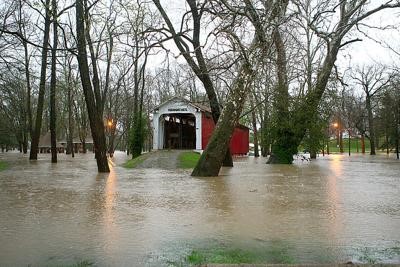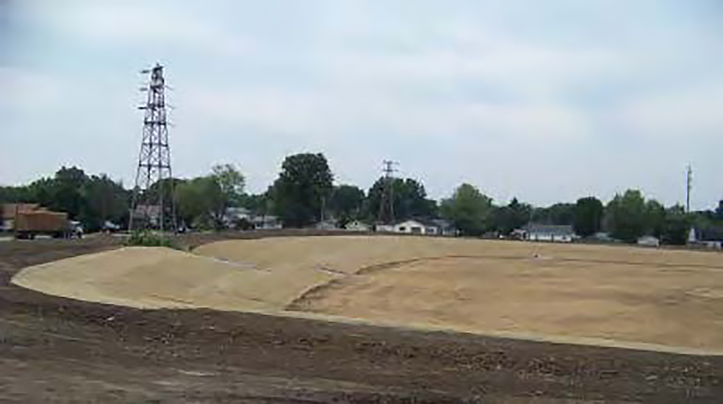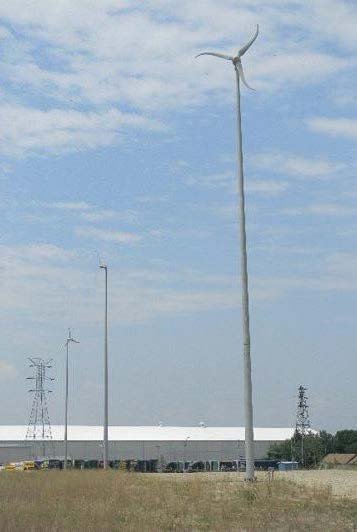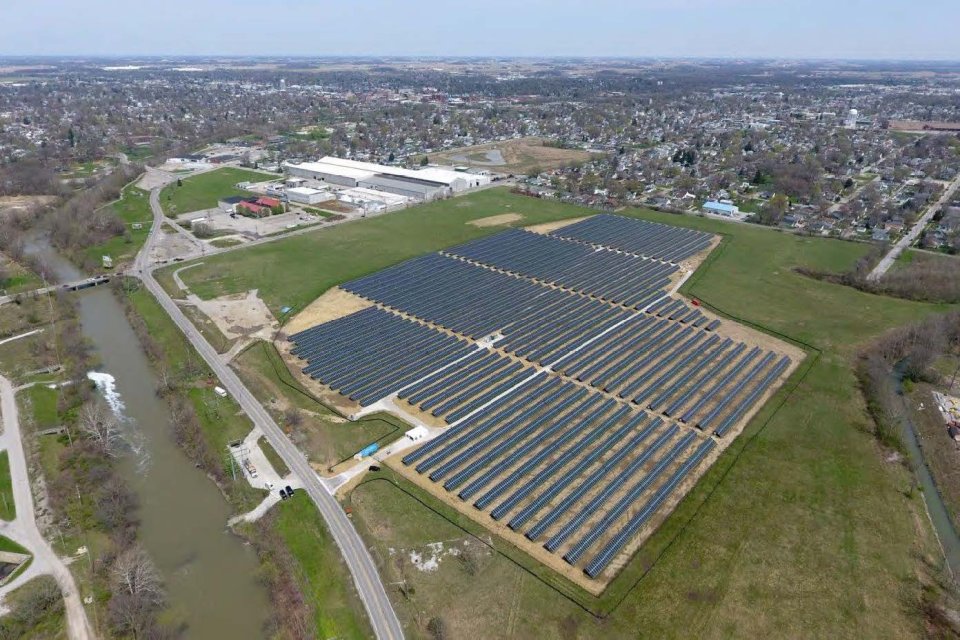Climate Adaptation Profile: Continental Steel Corp.
Kokomo, Indiana
Site Description
Past use of the 183-acre Continental Steel Corp. site to manufacture steel products resulted in soil, sediment, surface water and groundwater contamination with volatile organic compounds, polychlorinated biphenyls and metals such as lead. Areas of concern encompassed the main manufacturing plant, a quarry, acid lagoons, and a slag processing and disposal area. Another area of concern comprises two onsite creeks, the Wildcat Creek and its Kokomo Creek tributary. Both creeks have been identified as impaired waters within the Wabash River Watershed.
Remediation Activities
Source contamination was addressed by dredging, excavating or consolidating contaminated soil and waste material for onsite capping or offsite disposal. Additionally, heated soil vapor extraction was conducted in the northwest corner of the former “main plant” area. Three groundwater extraction systems have operated onsite since 2011 to treat the groundwater plume and prevent its migration. Of these, one uses seven wells positioned in a series parallel to Wildcat Creek to intercept contaminants in shallow groundwater otherwise entering the creek. The additional extraction systems use two wells at the Markland Avenue Quarry, which had been used for waste disposal, and seven wells in the former lagoon area previously used for waste acid treatment and disposal. The city of Kokomo took ownership of the site in late 2013.
Vulnerability to Climate Change Impacts

The site is vulnerable to flooding and associated soil and sediment erosion; approximately half of the site lies in a 100-year floodplain. For example, record amounts of heavy and extended rainfalls in April 2013 resulted in Wildcat Creek water levels reaching more than 18 feet above the creek’s base, 16 feet higher than the normal elevation. Loss of electricity power and physical damage associated with potential tornadoes pose additional vulnerabilities. National Oceanic and Atmospheric Administration (NOAA) data indicate that in 2013 Indiana experienced the largest outbreak of November tornadoes in the state’s recorded history.
Building Adaptive Capacity for Future Climate Scenarios

Climate adaptation measures taken at the Continental Steel Corp. site focus on building climate resilience by optimizing stormwater management, weather-proofing the groundwater extraction systems, and using the site’s renewable energy sources. In conjunction with site reuse planning, the site’s former quarry pond was excavated and backfilled to levels 8 to 10 feet below surrounding grades, thereby creating a 4-acre stormwater retention basin capable of storing up to 58,000 cubic yards of stormwater. The city of Kokomo concurrently installed new water lines that would direct stormwater from adjacent neighborhoods to the basin instead of the city’s combined sewer system. The basin also stores water accumulating in onsite areas, including parcels undergoing redevelopment. Infiltration of stormwater in the vicinity of the basin is fostered by prairie grasses, native plants and trees planted by the city. During April 2013 flooding, the area of the stormwater retention basin area significantly reduced onsite runoff and successfully stored stormwater runoff from adjacent areas.
Soft engineering techniques were used to minimize potential stormwater runoff and associated erosion at the 87-acre main plant area, which predominantly slopes toward Wildcat Creek. During remedial excavation and backfilling, chipped wood from onsite trees requiring removal was used to construct berms in vulnerable areas and to buffer site roads or augment other erosion controls. Additionally, large granite field stone was placed along the sides of Wildcat Creek and Kokomo Creek to armor their banks.
Multiple flood resilience measures were integrated into design and construction of the groundwater extraction and monitoring wells, which are flush mounted. Each extraction well was sealed with grout containing 3/8-inch chips of pure sodium bentonite clay and each monitoring well was sealed with grout containing bentonite in the form of 1/4-inch pellets or slurry. The ends of extraction well casings were joined by watertight welded steel and the tops of well casings were sealed with well caps extending at least five feet below ground surface. To prevent backflow of floodwater during flooding, check valves were installed in all extraction and monitoring wells. Each of the three groundwater extraction systems also was equipped with a remote monitoring system that includes an auto dialer enabling shutdown in advance of potential flooding or other hazardous conditions.
The site’s three 96-square-foot pumphouses, which also store remedial supplies, were constructed in accordance with the Indiana Building Code for industrialized building systems and local ordinance. The ordinance includes structural design specifications regarding rain, flood, wind, snow, earthquake and atmospheric ice loads. Operation and maintenance of the buildings includes any needed repair of waterproof, expandable sealant around pipes that extend through the pump house floors. An acid tote locker required for remedial purposes was placed near one pumphouse located outside the 500-year floodplain and bolted onto its concrete slab to prevent damage or movement associated with weather extremes. Collectively, the design and construction specifications for the groundwater extraction systems and supporting structures have provided resilience to flooding conditions such as those occurring in April 2013.

Generation of energy from the site’s renewable resources additionally advances the site’s adaptation to climate change impacts and simultaneously reduces greenhouse gas emissions contributing to climate change. Operation of three 2.4 kilowatt (kW) grid-tied wind turbines in the former quarry area offsets up to 60 percent of the grid electricity needed to power the three groundwater extraction systems. Automated controls enable the wind turbines to operate at wind speeds of 6 to 35 miles per hour, which enables electricity production during relatively light winds and minimizes potential turbine damages under severe wind conditions. The groundwater extraction systems collectively utilize 16 wells from which water is continuously extracted at a rate of up to 266 gallons per minute (gpm). Through remotely controlled operations, the extracted groundwater is directed to the nearby Kokomo wastewater treatment plant.
A small-scale, off-grid solar energy system is used to intermittently pump contaminated groundwater and fuel oil that accumulates in a concrete-lined sump along an onsite intermittent stream, at the past location of storage tanks in the main plant area. The system consists of a 75 watt photovoltaic (PV) panel that directly powers an extraction pump capable of withdrawing up to 25 gpm of liquid during daylight hours.
In 2016, a 7.2 megawatt solar energy farm was constructed in the vicinity of the site’s former manufacturing plant. The solar farm consists of approximately 21,000 PV panels and supporting infrastructure located across 26 acres where contaminated material had been covered with the soil cap. The solar farm generates about 9.1 million kW of electricity each year, which is enough to power 1,000 typical homes. Through a 20-year power purchase agreement, Alterra Power Corp manages the project, Inovateus Solar LLC constructed and maintains the solar farm under a lease with the city of Kokomo, and Duke Energy Indiana purchases and distributes 100 percent of the generated electricity. The property lease provides a $36,000 revenue to the city each year. Adjacent space is available for potential expansion of the solar farm.

Superfund Climate Resilience
EPA provides additional information about approaches for building climate resilience at Superfund sites.
Overview of Climate Adaptation Measures
EPA Region 5, the Indiana Department of Environmental Management (IDEM), and the city of Kokomo have collaborated in multiple adaptation measures:
- Used nature-based solutions to increase infiltration of rainwater and snow/ice melt and prevent erosion.
- Developed capacity to store onsite stormwater and local runoff.
- Used water-tight materials to construct and protect components of groundwater extraction and monitoring wells.
- Installed check valves in groundwater extraction and monitoring wells to prevent floodwater backflow.
- Integrated specifications regarding tolerance of extreme weather and other natural hazards into building designs.
- Using remote control technology that enables rapid shutdown and startup of remedial operations from multiple onsite or offsite locations.
- Using a renewable energy system to directly power remedial equipment.
- Generating diversified renewable energy for delivery to the local utility grid.
Key Tools for Incorporating Climate Projections
- Indiana Water Balance Network, Indiana Geological & Water Survey, Indiana University
- National Ground-Water Monitoring Network, U.S. Geological Survey (USGS)
- Weather and Climate Resources, National Oceanic and Atmospheric Administration
- Water Data for the Nation, USGS
Points of Contact
- Nabil Fayoumi, EPA Region 5
- Jessica Huxhold Fliss, Indiana Department of Environmental Management
References
- Operation and Maintenance Plan: Operable Unit 1 Groundwater Extraction System, Continental Steel Superfund Site, June 2020, EPA Region 2
- Fourth Five-Year Review Report: Continental Steel Corp. Superfund Site, August 2017, EPA Region 5
- April 18-19, 2013 Heavy Rain and Flooding, NOAA National Weather Service, Indianapolis, IN
- November 17, 2013 Severe Weather and Tornado Outbreak, NOAA National Weather Service, Indianapolis, IN
- Continental Steel Superfund Site: Hydrogeological (Groundwater Sampling) Investigation, May 2010, CH2M Hill
August 2022
